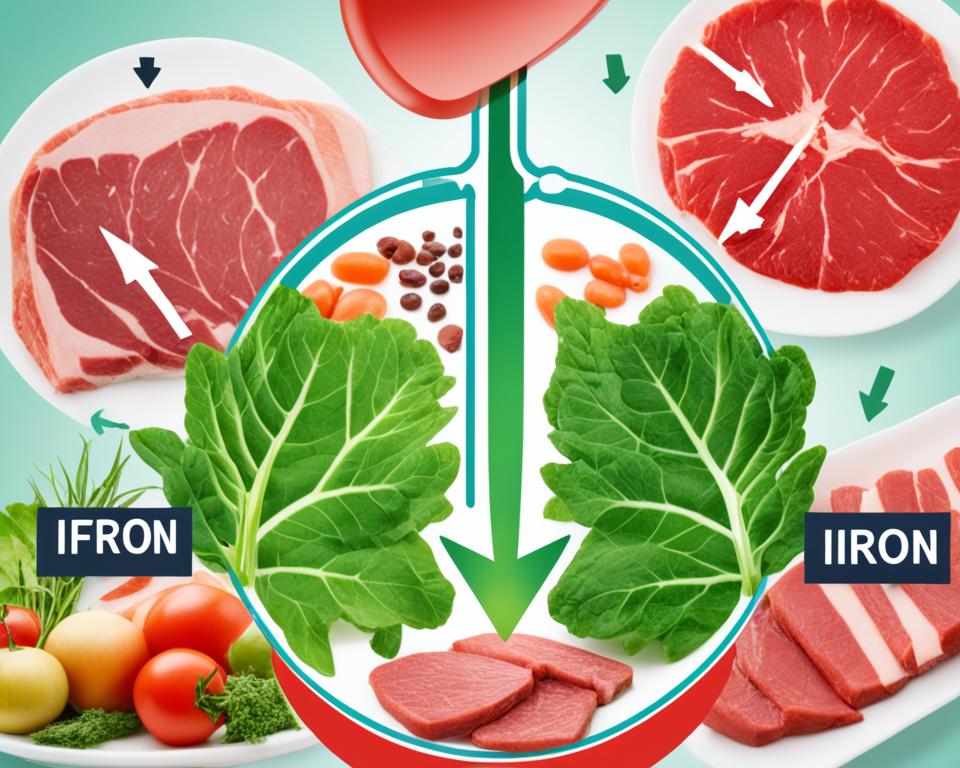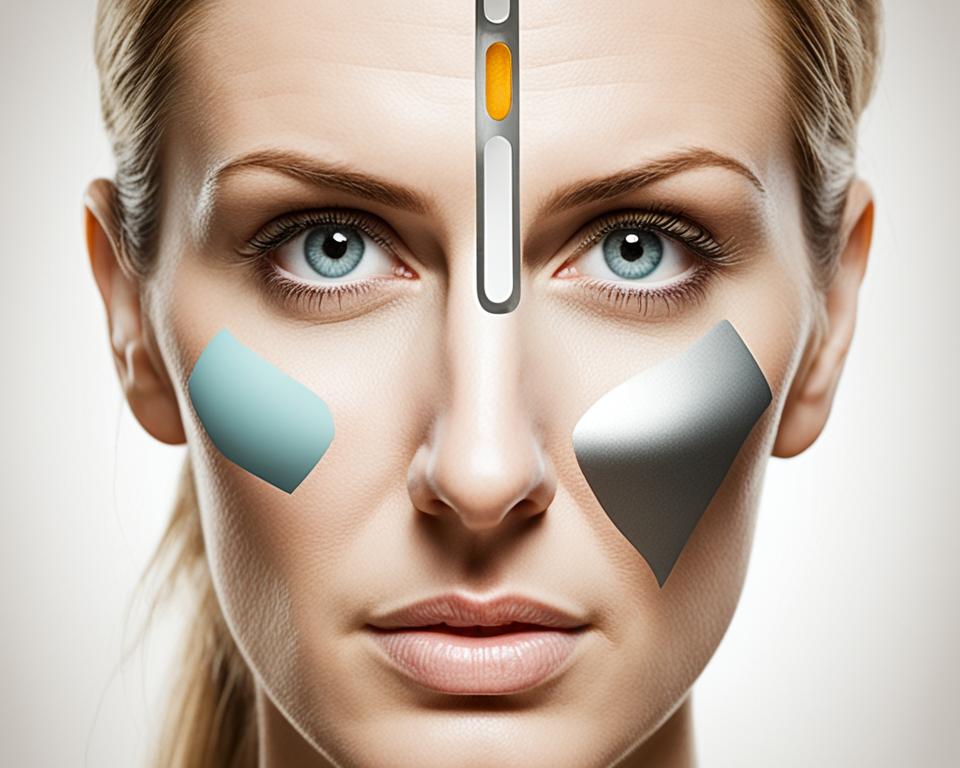Iron deficiency is a common issue that affects many people’s health. It’s often linked to anemia, which means low hemoglobin levels. But, it’s important to know that you can have iron deficiency without anemia too. This condition, called iron deficiency without anemia, has its own set of symptoms and needs special care.
Read interesting things at : vsocan
Key Takeaways
- Iron deficiency without anemia is a common condition that can have significant effects on overall health and well-being.
- It is characterized by low iron stores in the body, despite normal hemoglobin levels.
- Identifying the symptoms, causes, and diagnostic tests for iron deficiency without anemia is crucial for effective treatment.
- Dietary modifications and supplementation can help address iron deficiency without anemia.
- Underlying conditions and lifestyle factors must be considered for comprehensive management of this condition.
Understanding Iron Deficiency Without Anemia
Iron deficiency without anemia, also known as non-anemic iron deficiency or functional iron deficiency, is a condition. It happens when the body has low iron stores but doesn’t meet anemia criteria. People with this condition may feel some iron deficiency symptoms but their hemoglobin levels are normal.
What is Iron Deficiency Without Anemia?
This condition occurs when the body’s iron stores are low but hemoglobin levels don’t drop enough to be anemic. It can happen if the body doesn’t get enough iron from food, can’t absorb it well, or needs more iron than usual.
Prevalence and Risk Factors
Many people don’t know that non-anemic iron deficiency is common. It affects up to 30% of people worldwide. Women and children are especially at risk. Key risk factors include:
- Inadequate dietary intake of iron-rich foods
- Malabsorption disorders, such as celiac disease or inflammatory bowel conditions
- Increased iron demands during periods of growth, pregnancy, or intense physical activity
- Chronic blood loss, such as from heavy menstrual periods or gastrointestinal bleeding
Knowing about non-anemic iron deficiency and its risk factors is important. It helps in catching it early and preventing health problems.
Symptoms of Iron Deficiency Without Anemia
Iron deficiency without anemia may not show up as anemia does, like pale skin or extreme tiredness. But, it can cause many symptoms that are important to know. These symptoms help spot and treat iron deficiency early.
Physical Symptoms
A common sign of iron deficiency without anemia is fatigue. People may feel very tired even after resting a lot. Other signs include weakness, headaches, and hair loss. Some might also have restless leg syndrome, wanting to move their legs a lot, especially at night.
Cognitive and Emotional Symptoms
Iron deficiency without anemia can affect how we think and feel. People might find it hard to concentrate, remember things, and do their work well. Mood changes, like irritability and depression, are also common. These symptoms can really change daily life and overall happiness.
“Iron deficiency without anemia can have a significant impact on both physical and mental well-being, making it crucial to recognize and address the symptoms early on.”
Knowing about the many symptoms of iron deficiency without anemia helps people take action. This can greatly improve their health and happiness.
Causes of Iron Deficiency Without Anemia
Iron deficiency without anemia, also known as non-anemic iron deficiency, can come from many factors. These factors make it hard for the body to absorb or use iron well. It’s important to know the causes to find good ways to fix it.
One big cause of iron deficiency without anemia is not getting enough iron from food. This happens if you eat too little red meat, poultry, seafood, or fortified grains. People who don’t eat meat, like vegetarians and vegans, might get less iron from plants because it’s harder for the body to absorb.
Some stomach problems, like not absorbing nutrients well or diseases like inflammatory bowel disease, can also lead to iron deficiency without anemia. These issues can make it hard for the body to absorb iron or cause ongoing iron loss. This stops the body from keeping enough iron.
- Insufficient dietary iron intake
- Malabsorption disorders
- Inflammatory bowel diseases
- Chronic blood loss from gastrointestinal conditions
Some medical conditions, like chronic kidney disease, heart failure, or thyroid problems, can also cause iron deficiency without anemia. These conditions might make the body need more iron or affect how it uses iron.
Knowing what causes iron deficiency without anemia is key to fixing it and keeping iron levels right. By finding and fixing these issues, doctors can make plans to help people get and keep healthy iron levels.
Diagnostic Tests for Iron Deficiency Without Anemia
Identifying iron deficiency without anemia needs a detailed approach with different tests. It’s important to check iron levels correctly to start treatment early.
Blood Tests
The main way to spot iron deficiency without anemia is through blood tests. These tests look at several important levels:
- Ferritin levels – Ferritin is a protein that holds iron in the body. Low levels mean you might be lacking iron, even if you’re not anemic.
- Transferrin levels – Transferrin carries iron in the blood. High levels can show you’re not getting enough iron.
- Hemoglobin levels – Hemoglobin might seem okay, but a small drop can hint at iron deficiency.
Other Diagnostic Methods
Doctors also use other ways to check for iron deficiency without anemia:
- Imaging tests – MRI or CT scans can find out why you might be losing iron, like from bleeding or poor absorption.
- Endoscopic procedures – These tests look inside your gut to see where iron is going missing or not being absorbed well.
By using many tests, doctors can find iron deficiency without anemia and make a treatment plan just for you.
| Test | Purpose | Significance in Iron Deficiency Without Anemia |
|---|---|---|
| Ferritin | Measures stored iron in the body | Low ferritin levels are a hallmark of iron deficiency, even in the absence of anemia |
| Transferrin | Evaluates iron transport in the blood | Elevated transferrin levels can indicate iron deficiency |
| Hemoglobin | Assesses the oxygen-carrying capacity of the blood | Hemoglobin may remain within the normal range, but a slight decrease can be observed |
Dietary Sources of Iron
The foods we eat are key to keeping our iron levels healthy. There are two main types of dietary iron: heme and non-heme. Knowing the difference helps us get the most iron from our food.
Heme and Non-Heme Iron
Heme iron is in foods like red meat, poultry, and fish. It’s easy for our bodies to absorb. Non-heme iron is in plants like leafy greens, legumes, and fortified cereals. It’s not as easily absorbed but is still vital for our iron needs.
Combining heme and non-heme iron sources in meals boosts iron absorption. For instance, eating a lean steak with spinach or lentils helps our bodies use the iron better.
Other things can affect how well our body absorbs iron. Vitamin C can help, but some foods like phytates can slow it down. Being aware of these can help us make the most of iron in our diet.
Enhancing Iron Absorption
Getting enough iron is key for good health, especially if you’re at risk of not having enough. Luckily, there are ways to make the iron in your diet work better for you.
Combining Foods for Better Absorption
One good way is to eat iron-rich foods with foods high in vitamin C. Vitamin C, or ascorbic acid, helps your body absorb non-heme iron better. This is the type of iron found in plants.
Try eating foods like leafy greens, beans, or whole grains with citrus fruits or bell peppers. This can really help your body use the iron you eat.
Fermented foods like sauerkraut, kimchi, and miso can also help with iron absorption. These foods get broken down during fermentation. This makes the iron easier for your body to use.
Adding these foods to your meals can make your body use the iron better. This is good for your health and well-being.

Iron Deficiency Without Anemia
Iron deficiency without anemia is a condition that is often overlooked. It is also known as non-anemic iron deficiency or functional iron deficiency. Unlike clinical anemia, it doesn’t show up as a low red blood cell count or low hemoglobin levels. Instead, it has subtle symptoms that can still affect health and well-being.
In iron deficiency without anemia, the body’s iron stores are low, but the hemoglobin levels are normal. This means you might not see the usual signs of anemia like pale skin, feeling tired, or shortness of breath. But, your cells and tissues might not have enough iron, leading to functional problems.
Symptoms of Iron Deficiency Without Anemia
- Decreased exercise capacity and endurance
- Impaired cognitive function, including difficulty concentrating and poor memory
- Restless leg syndrome or other neurological symptoms
- Increased susceptibility to infections
- Brittle nails and dry, thinning hair
These symptoms can really affect how you live your life. It’s important to recognize and treat iron deficiency, even if you don’t have clinical anemia.
Causes and Risk Factors
Iron deficiency without anemia can happen for many reasons, including:
- Not getting enough iron from food
- Iron absorption issues due to gut problems or certain medicines
- Increased iron needs during growth, pregnancy, or intense exercise
- Blood loss from heavy periods or other bleeding issues
Some groups are more likely to get this condition. These include women of childbearing age, endurance athletes, and people with gut disorders.
It’s important to recognize and treat iron deficiency without anemia to stay healthy. By knowing the signs, causes, and risk factors, you can take steps to keep your iron levels up and avoid its negative effects.
Iron Supplements for Non-Anemic Iron Deficiency
Iron deficiency without anemia is serious and needs attention. It’s important to treat it properly. Iron supplements are a key way to tackle this issue.
Types of Iron Supplements
Iron supplements come in different forms, each with its own benefits and things to consider. Here are the main types:
- Ferrous sulfate: This is a common and affordable option, often prescribed by doctors.
- Ferrous gluconate: It’s absorbed better than ferrous sulfate and is good for those who are sensitive.
- Ferrous fumarate: This type is easy to take and helps increase iron levels well.
- Heme iron polypeptide: Coming from animals, it’s absorbed better by the body than other types.
Dosage and Side Effects
The right amount of iron supplements depends on your age, how severe your deficiency is, and how your body reacts. Usually, taking 15-30 mg of iron a day is enough. Taking more can cause stomach problems like constipation and nausea. Always talk to a doctor before starting iron supplements to get the best advice and avoid side effects.
| Iron Supplement | Typical Dosage | Potential Side Effects |
|---|---|---|
| Ferrous Sulfate | 15-30 mg elemental iron per day | Constipation, nausea, abdominal discomfort |
| Ferrous Gluconate | 15-30 mg elemental iron per day | Mild gastrointestinal discomfort |
| Ferrous Fumarate | 15-30 mg elemental iron per day | Constipation, nausea, diarrhea |
| Heme Iron Polypeptide | 11-15 mg elemental iron per day | Generally well-tolerated |
Knowing about the different iron supplements and how much to take helps people with iron deficiency without anemia. They can work with their doctors to find the best treatment and manage their iron levels well.
Managing Underlying Conditions
When dealing with iron deficiency without anemia, it’s key to tackle any underlying issues. These can include things like stomach problems or ongoing inflammation. Fixing these problems can really help improve your iron levels.
Gastrointestinal disorders are a common cause of iron deficiency without anemia. Issues like inflammatory bowel disease or chronic bleeding can make it hard for your body to absorb iron. Working with your doctor to manage these problems can help fix the root cause of your iron deficiency.
Chronic inflammation can also play a role. This can come from autoimmune diseases, chronic infections, or other health issues. Finding and treating the cause of inflammation can help get your iron levels back on track.
Some people might have hormonal imbalances that affect their iron levels. This could be due to conditions like hypothyroidism or changes during the menstrual cycle. Fixing these hormonal issues can also help improve your iron status.
Comprehensive Approach to Iron Deficiency Treatment
To manage iron deficiency without anemia well, you need a full plan. This plan should cover any underlying conditions. It might include:
- Running tests to find the main cause
- Creating a treatment plan with a healthcare provider
- Making dietary changes to get more iron and absorb it better
- Taking iron supplements if your doctor suggests it
- Keeping an eye on your progress and changing the plan as needed
By tackling the main causes of iron deficiency causes, you can help your body keep healthy iron levels, even if you’re not anemic. This full approach can lead to better iron deficiency treatment results.

| Underlying Condition | Potential Impact on Iron Deficiency | Recommended Approach |
|---|---|---|
| Gastrointestinal Disorders | Impaired iron absorption due to chronic inflammation or bleeding | Manage the underlying GI condition through medication, dietary changes, or other treatments |
| Chronic Inflammation | Disruption of iron metabolism and utilization | Identify and address the source of chronic inflammation, such as autoimmune diseases or chronic infections |
| Hormonal Imbalances | Fluctuations in iron levels due to hormonal changes | Evaluate and treat underlying hormonal conditions, such as hypothyroidism or menstrual cycle irregularities |
Iron Deficiency Without Anemia in Pregnancy
Pregnancy can make it hard to keep enough iron, even if you’re not anemic. This means your iron levels are low but not low enough to be called anemia. It’s important to know the risks and how to prevent it to keep you and your baby healthy.
Risks and Prevention
Not having enough iron during pregnancy can lead to serious problems. These include a higher chance of giving birth too early, having a baby that’s too small, and issues with the baby’s brain development. The mom might feel very tired, have less energy, and get more infections.
To avoid iron deficiency without anemia during pregnancy, doctors suggest a few steps:
- Regular prenatal screening and monitoring of iron levels
- Eating more iron-rich foods like red meat, poultry, legumes, and fortified cereals
- Taking iron supplements if a doctor says so
- Dealing with any health issues that might make you lose iron, like heavy periods or stomach problems
By taking steps early, doctors can help make sure you and your baby stay healthy.
Iron Deficiency in Athletes and Active Individuals
Athletes and those who are very active often risk not having enough iron. This is because their bodies use more iron when they exercise. It’s important to know why this happens to keep up performance and health.
Factors Contributing to Iron Deficiency in Athletes
- Increased iron needs for more red blood cells and muscle
- More iron lost through sweat, bleeding, and urine
- Not eating enough iron-rich foods
- Inflammation from hard training that makes iron harder to absorb
Recognizing the Signs of Iron Deficiency in Athletes
Athletes with low iron might feel very tired, can’t do as much exercise, and take longer to recover. They might also have trouble focusing and feel irritable.
Maintaining Optimal Iron Status for Athletes
To avoid iron deficiency, athletes should eat more iron-rich foods like red meat, poultry, seafood, and fortified grains. Eating foods high in vitamin C can help your body absorb iron better. Sometimes, taking iron supplements is needed, but always talk to a doctor first to get the right amount and avoid side effects.
| Iron-Rich Food | Iron Content (per serving) |
|---|---|
| Beef, cooked | 2.7 mg per 3 oz |
| Lentils, cooked | 3.3 mg per 1 cup |
| Spinach, cooked | 3.6 mg per 1 cup |
| Fortified cereal | 18 mg per 1 cup |
Fixing iron deficiency helps athletes do better in sports, recover faster, and stay healthy and happy.
“Optimal iron status is crucial for athletic performance, as it supports the delivery of oxygen to working muscles and the production of energy.”
Functional Iron Deficiency
Iron deficiency without anemia is a serious issue, but there’s another problem called functional iron deficiency. This happens when you have enough iron but can’t use it right. It affects how your body works.
There are many reasons why you might have this, like chronic inflammation, being overweight, or certain health issues. These can make it hard for your body to use iron well. So, you might have enough iron but not enough for your body’s needs.
Even with normal iron levels, you might feel tired, weak, or not sharp mentally. You might also have trouble doing physical activities. This shows how important it is to manage this kind of iron imbalance well.
Identifying Functional Iron Deficiency
To figure out if you have this, doctors use blood tests and check you over. They look for certain signs, like:
- Normal or high ferritin levels (which shows how much iron you have stored)
- Low transferrin saturation (which shows how much iron is being carried in your blood)
- High inflammatory markers, like C-reactive protein or interleukin-6
- Feeling iron-deficient symptoms even with normal hemoglobin levels
Fixing this issue often means changing your diet, taking supplements, and managing any health problems you have. It’s important to talk to a doctor to get the right treatment plan.
| Parameter | Normal Range | Functional Iron Deficiency |
|---|---|---|
| Ferritin | 15-200 ng/mL | Normal or elevated |
| Transferrin Saturation | 20-50% | Low ( |
| Inflammatory Markers | Normal | Elevated (e.g., CRP, IL-6) |
Understanding functional iron deficiency helps doctors treat it better. This can make people healthier and happier.
Iron Deficiency Without Anemia in Children
Many children suffer from iron deficiency without showing signs of anemia. This can slow down their growth and affect their thinking and health. It’s important to know the signs and effects to help them grow right.
Symptoms and Developmental Impact
Kids with iron deficiency might feel tired, eat less, and grow slower. But the big effects are on their thinking and behavior. They might have trouble paying attention, learning, and solving problems. These issues can affect how well they do in school and with friends.
Iron deficiency can also hurt their brain and motor skills. This means they might not hit important milestones on time. It can slow down their growth and thinking skills.
| Symptoms of Iron Deficiency Without Anemia in Children | Potential Developmental Impact |
|---|---|
|
|
Spotting and treating iron deficiency early in kids is key. It helps prevent problems and keeps them healthy and growing well.
Lifestyle Changes for Better Iron Status
Keeping a healthy iron level is more than just about what you eat. Making some lifestyle changes can really help your body use iron better. By changing a few things, you can help keep your iron levels up and fight iron deficiency without anemia.
One big change is to eat more dietary iron. Add foods high in iron like red meat, poultry, seafood, beans, and fortified cereals to your meals. Also, eating foods high in vitamin C with these can make your body absorb iron better.
- Enjoy citrus fruits, bell peppers, broccoli, and tomatoes alongside your iron-rich meals.
- Avoid consuming tea, coffee, or calcium-rich foods immediately before or after your iron-rich meals, as they can inhibit iron absorption.
Getting enough sleep is another key change. Good sleep helps your body manage iron levels and use nutrients well. Try to sleep 7-9 hours each night to help your health and iron levels.
Exercise can also help with iron absorption and use. Regular, moderate exercise helps blood flow and gets iron moving in your body. But don’t exercise too much, as it can lead to losing more iron.
| Lifestyle Factor | Impact on Iron Status |
|---|---|
| Dietary Iron Intake | Directly influences the amount of iron available for absorption and utilization. |
| Vitamin C Consumption | Enhances the body’s ability to absorb non-heme iron from plant-based sources. |
| Sleep Quality | Supports the regulation of iron levels and overall nutrient utilization. |
| Exercise Routine | Promotes blood flow and iron transport, but excessive exercise can lead to increased iron losses. |
By adding these lifestyle changes to your daily life, you can actively work on keeping a healthy iron status and fighting iron deficiency without anemia. A good plan includes eating right, maybe taking supplements, and making lifestyle changes. This is the best way to boost your iron levels and improve your health.
Conclusion
Iron deficiency without anemia is a common issue that affects many people. It can impact your health in many ways, including your physical, mental, and emotional health. By knowing the signs, finding the cause, and taking action, you can keep your iron levels healthy.
This article has covered the details of iron deficiency without anemia. We talked about how common it is, who is at risk, and how to test for it. We also looked at ways to improve iron intake through diet and supplements.
It’s important to remember that iron deficiency, even if you don’t have anemia, is something to pay attention to. With the help of healthcare experts, you can create a plan that meets your needs. This way, you can keep your iron levels right for better health overall.


